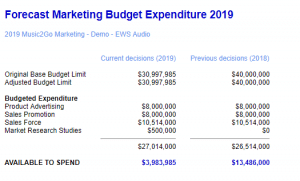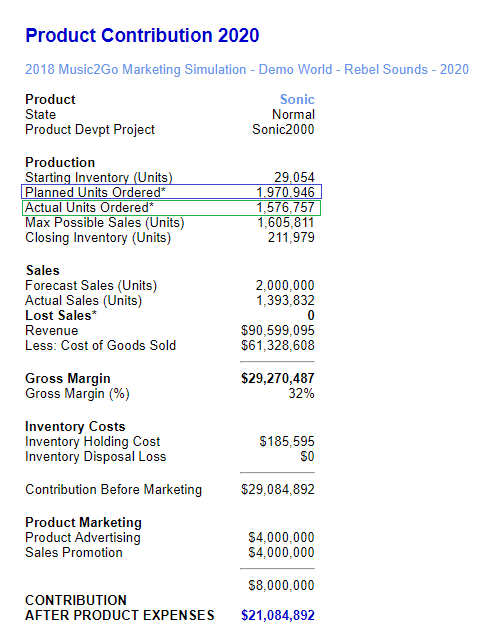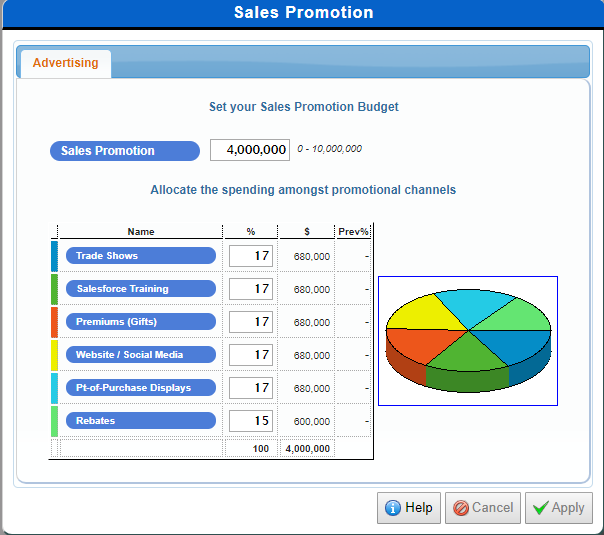Mistakes are the stepping stones to success.
– John C. Maxwell
What are the other common mistakes in Music2Go Marketing?
In Part Two, we’ll talk about the importance of reaching the right customers and how to better allocate your Sales Promotion Mix.
Here’s Part One of the article in case you missed it.
Mistake #4: Misunderstanding the Importance of Reaching the Right Customers
Not understanding this can be a costly mistake as it often leads to incorrectly assigning your Advertising Mix. This can have a negative impact on the demand for your products and can also lead to overspending. Meaning your firm’s profitability is at risk!
How do you know if you are spending your advertising budget inefficiently? Follow through this section, it will show you how to efficiently allocate your advertising budget.
Each market segment is sensitive to different dimensions. View the Market Information report.

How do I interpret this Product Dimension Sensitivities graph?
The best way to explain it is through an example. If you take the Standard segment, you’ll see it has a high sensitivity to Price. This means that an increase to your price (example setting the price to the maximum) is going to have a negative effect on your sales volume.
What these sensitivities mean is a change in any of these factors, will result in a proportionate change in the consumers’ demand for your product(s).
There are four media choices to develop your advertising mix on: Television, Newspapers, Magazines and Digital Media.
There are two substantial sources of information you can use to determine your optimal advertising mix for a given advertising spend: Advertising and PR Reach by Media Curve and Media Viewing Habits. Both information can be found in the Market Information report.
Each media type can reach a given proportion of its audience for a given investment. This is shown within the Advertising and PR Reach by Media Curve.
The best way to explain this would be to provide an example.
Example: Budget of $4 million on Standard Segment.
Option 1: 42% of the Standard Segment read magazines.
So our $4 million spend would reach approximately 90% (taken from the graph at a spend of $4 million) x 42% (Media Viewing Habits) = 37.8% of the Standard segment can be reached
Option 2: 85% of the Standard Segment can be reached via Digital Media.
So our $4 million spend would reach approximately 50% (taken from the graph at a spend of $4 million) * 85% (Media Viewing Habits) = 42.5% of the Standard segment
Option 3: But maybe we can do better than that still. What happens if we spend $2 million on Newspapers, and $2 million on Magazines?
If we spend $2 million on Newspapers, we could reach approximately 40% of Newspaper viewers and 58% of the Standard segment reads Newspapers. So we could reach approximately 40% (Media Viewing Habits) x 58% (taken from the graph at a spend of $2 million) = 23.2% of the Standard Segment.
If we spend $2 million on Magazines we could reach approximately 50% of Magazine viewers and 42% of the Standard segment reads Magazines. So we could reach approximately 50% (Media Viewing Habits) x 42% (taken from the graph at a spend of $2 million) = 21% of the Standard segment.
So, together our $4 million spent half on Newspapers and half on Magazines would reach approximately 44.2% of the Standard segment, which is obviously a better use of our Advertising budget than the first two options.
As you can see, with the same budget, but a different allocation towards each media channel can make a huge difference in the amount of consumers you can reach.
This is only an example of good and bad marketing mixes. This is far from the best mix you can make. We suggest playing around on different Marketing Mix and see what works best for your strategy and budget.
Mistake# 5: Inaccurately Allocating Your Sales Promotion Mix
Your Sales Promotion strategy will need to vary with the Life Cycle of your product. For instance, Trade Shows and Sales Force training will be important a new product launch, bur progressively less so as the product ages. Your existing product will be in the Mature phase of its life cycle for your first Sales Promotion decision (Sales Promotion decisions are available after the 1st rollover).
It is important that you get your Sales Promotion Mix right, because it helps boost your distribution coverage and distribution index. In addition, some segments are particularly sensitive to Distribution, such as the Standard Segment.
There are 6 types of Sales Promotion activities available to you to promote your products and support your distributors:
- Trade Shows
- Salesforce Training
- Premiums (Gifts)
- Website/Social Media
- Point of Purchase Displays
- Rebates
So, how do I choose a Sales Promotion Mix for my products?
Remember that each of your products will progress through the Product Life Cycle starting in the Growth phase for new products and then gradually progressing through to the Decline stage over the next six rollovers.
Say we launch a new Youth product this period. This new product will start in the Growth phase of the Product Life Cycle (See Market Information Report > Sales Promotion). Then from looking at the tables above, we can see that our Ideal Sales Promotion Mix for a new Sports product is:
- Trade Shows – 15%
- Sales Force Training – 25%
- Premium (Gifts) – 5%
- Website and Social Media – 25%
- Point of Purchase Displays – 25%
- Rebates – 5%
Total = 100%
That was a simple example, but what happens in the second year that we sell this Youth product? The product will be moved from the “Growth” phase to “Growth – Starting to Mature.” So the optimal Sales Promotion mix will be 1/3 of the way between the ideal Growth and Mature figures in the Sales Promotion Table. That would give us an optimal Sales Promotion mix something like:
- Trade Shows – 10% (Ideal Growth = 15%, Ideal Mature= 5%)
- Sales Force Training – 17% (Ideal Growth = 25%, Ideal Mature= 10%)
- Premiums (Gifts) – 15% (Ideal Growth = 5%, Ideal Mature= 25%)
- Website and Social Media – 23% (Ideal Growth = 25%, Ideal Mature= 20%)
- Point of Purchase Displays – 25% (Ideal Growth = 25%, Ideal Mature= 25%)
- Rebates – 10% (Ideal Growth = 5%, Ideal Mature= 15%)
Total = 100%
You should buy the Distribution Coverage and Sales Promotion Market Research report for detailed information on the Sales Promotion Rating and Stage of Product Life Cycle for all firms in the Industry.

















